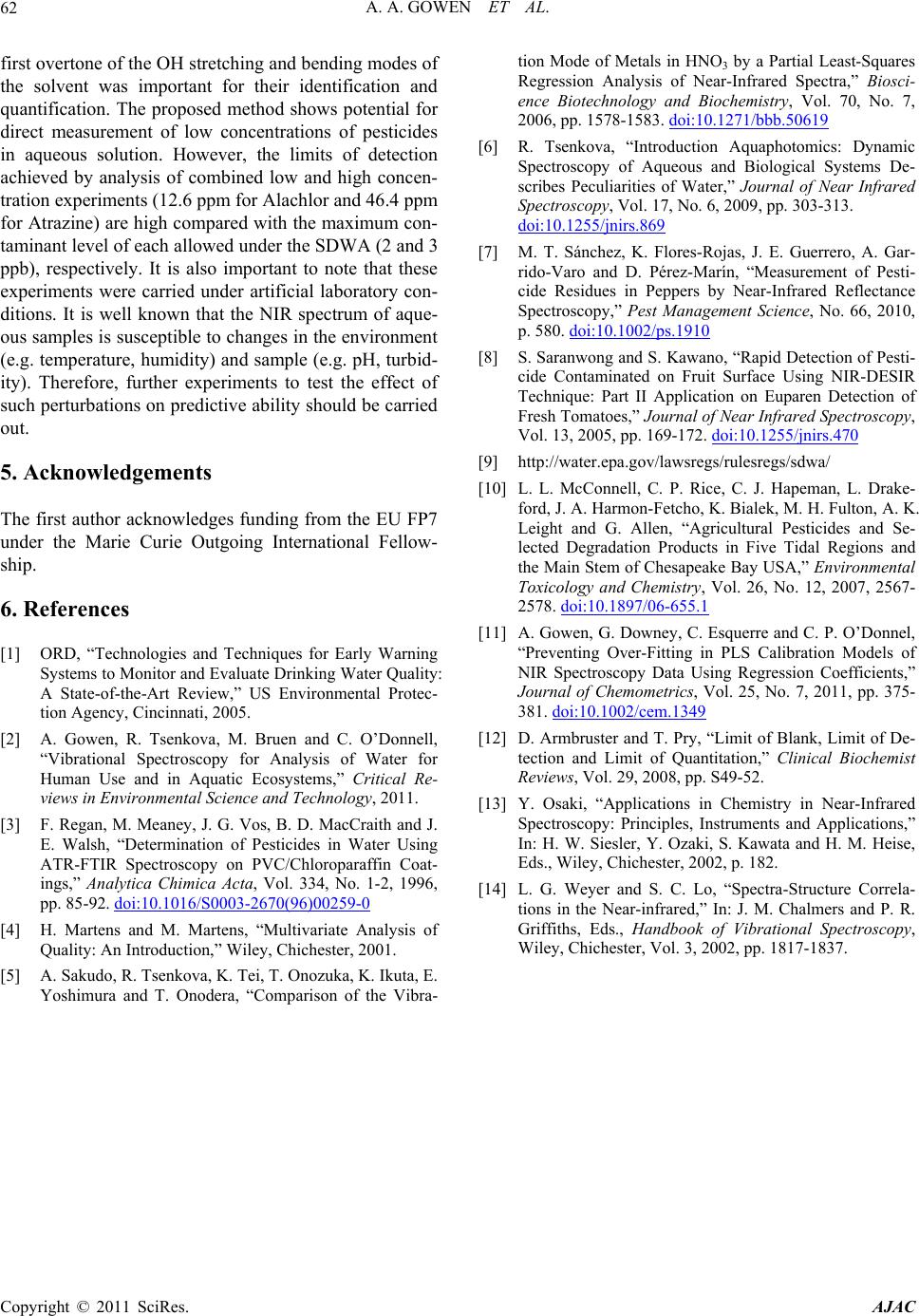
A. A. GOWEN ET AL.
62
first overtone of the OH stretching and bending modes of
the solvent was important for their identification and
quantification. The proposed method shows potential for
direct measurement of low concentrations of pesticides
in aqueous solution. However, the limits of detection
achieved by analysis of combined low and high concen-
tration experiments (12.6 ppm for Alachlor and 46.4 ppm
for Atrazine) are high compared with the maximum con-
taminant level of each allowed under the SDWA (2 and 3
ppb), respectively. It is also important to note that these
experiments were carried under artificial laboratory con-
ditions. It is well known that the NIR spectrum of aque-
ous samples is susceptible to changes in the environment
(e.g. temperature, humidity) and sample (e.g. pH, turbid-
ity). Therefore, further experiments to test the effect of
such perturbations on predictive ability should be carried
out.
5. Acknowledgements
The first author acknowledges funding from the EU FP7
under the Marie Curie Outgoing International Fellow-
ship.
6. References
[1] ORD, “Technologies and Techniques for Early Warning
Systems to Monitor and Evaluate Drinking Water Quality:
A State-of-the-Art Review,” US Environmental Protec-
tion Agency, Cincinnati, 2005.
[2] A. Gowen, R. Tsenkova, M. Bruen and C. O’Donnell,
“Vibrational Spectroscopy for Analysis of Water for
Human Use and in Aquatic Ecosystems,” Critical Re-
views in Environmental Science and Technology, 2011.
[3] F. Regan, M. Meaney, J. G. Vos, B. D. MacCraith and J.
E. Walsh, “Determination of Pesticides in Water Using
ATR-FTIR Spectroscopy on PVC/Chloroparaffin Coat-
ings,” Analytica Chimica Acta, Vol. 334, No. 1-2, 1996,
pp. 85-92. doi:10.1016/S0003-2670(96)00259-0
[4] H. Martens and M. Martens, “Multivariate Analysis of
Quality: An Introduction,” Wiley, Chichester, 2001.
[5] A. Sakudo, R. Tsenkova, K. Tei, T. Onozuka, K. Ikuta, E.
Yoshimura and T. Onodera, “Comparison of the Vibra-
tion Mode of Metals in HNO3 by a Partial Least-Squares
Regression Analysis of Near-Infrared Spectra,” Biosci-
ence Biotechnology and Biochemistry, Vol. 70, No. 7,
2006, pp. 1578-1583. doi:10.1271/bbb.50619
[6] R. Tsenkova, “Introduction Aquaphotomics: Dynamic
Spectroscopy of Aqueous and Biological Systems De-
scribes Peculiarities of Water,” Journal of Near Infrared
Spectroscopy, Vol. 17, No. 6, 2009, pp. 303-313.
doi:10.1255/jnirs.869
[7] M. T. Sánchez, K. Flores-Rojas, J. E. Guerrero, A. Gar-
rido-Varo and D. Pérez-Marín, “Measurement of Pesti-
cide Residues in Peppers by Near-Infrared Reflectance
Spectroscopy,” Pest Management Science, No. 66, 2010,
p. 580. doi:10.1002/ps.1910
[8] S. Saranwong and S. Kawano, “Rapid Detection of Pesti-
cide Contaminated on Fruit Surface Using NIR-DESIR
Technique: Part II Application on Euparen Detection of
Fresh Tomatoes,” Journal of Near Infrared Spectroscopy,
Vol. 13, 2005, pp. 169-172. doi:10.1255/jnirs.470
[9] http://water.epa.gov/lawsregs/rulesregs/sdwa/
[10] L. L. McConnell, C. P. Rice, C. J. Hapeman, L. Drake-
ford, J. A. Harmon-Fetcho, K. Bialek, M. H. Fulton, A. K.
Leight and G. Allen, “Agricultural Pesticides and Se-
lected Degradation Products in Five Tidal Regions and
the Main Stem of Chesapeake Bay USA,” Environmental
Toxicology and Chemistry, Vol. 26, No. 12, 2007, 2567-
2578. doi:10.1897/06-655.1
[11] A. Gowen, G. Downey, C. Esquerre and C. P. O’Donnel,
“Preventing Over-Fitting in PLS Calibration Models of
NIR Spectroscopy Data Using Regression Coefficients,”
Journal of Chemometrics, Vol. 25, No. 7, 2011, pp. 375-
381. doi:10.1002/cem.1349
[12] D. Armbruster and T. Pry, “Limit of Blank, Limit of De-
tection and Limit of Quantitation,” Clinical Biochemist
Reviews, Vol. 29, 2008, pp. S49-52.
[13] Y. Osaki, “Applications in Chemistry in Near-Infrared
Spectroscopy: Principles, Instruments and Applications,”
In: H. W. Siesler, Y. Ozaki, S. Kawata and H. M. Heise,
Eds., Wiley, Chichester, 2002, p. 182.
[14] L. G. Weyer and S. C. Lo, “Spectra-Structure Correla-
tions in the Near-infrared,” In: J. M. Chalmers and P. R.
Griffiths, Eds., Handbook of Vibrational Spectroscopy,
Wiley, Chichester, Vol. 3, 2002, pp. 1817-1837.
Copyright © 2011 SciRes. AJAC